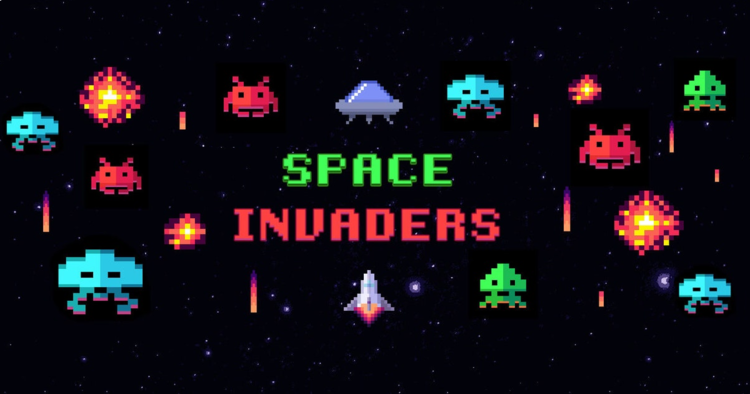Difference between revisions of "F20: Space Invaders"
Proj user1 (talk | contribs) (→Schedule) |
Proj user1 (talk | contribs) (→Technical Responsibilities) |
||
| Line 28: | Line 28: | ||
|- | |- | ||
! style="text-align: left;" | | ! style="text-align: left;" | | ||
| − | * PCB Design | + | * <span style="color:#556B2F">PCB Design</span> |
| Akhil Cherukuri | | Akhil Cherukuri | ||
|- | |- | ||
Revision as of 09:50, 10 November 2020
Contents
Abstract
Space Invaders is a fixed one person shooter style video game. The player controls a laser cannon by moving it horizontally across the bottom of the screen and firing at the aliens descending toward the cannon from the top of the screen. There are aliens descending towards the cannon and the player's main goal is to defeat an alien and earn points by shooting it with the laser cannon and destroying it. As more aliens are defeated, the aliens' movement speeds up. The alien invasion is declared successful and the game ends when the aliens have successfully reached the bottom. The final score of total kills is projected after the game ends. The mp3 decoder connected to the speaker will play sound effects required.
Introduction & Objectives
Show list of your objectives. This section includes the high level details of your project. You can write about the various sensors or peripherals you used to get your project completed.
Team Members
Technical Responsibilities
| Administrative Roles | ||||
|---|---|---|---|---|
|
Salvatore Nicosia, Akash Vachhani & Akhil Cherukuri **REVIEW** | |||
|
Akhil Cherukuri | |||
|
Salvatore Nicosia **REVIEW** | |||
|
Salvatore Nicosia, Akash Vachhani & Akhil Cherukuri **REVIEW** | |||
|
Akhil Cherukuri | |||
|
Akash Vachhani | |||
|
Salvatore Nicosia | |||
|
Salvatore Nicosia | |||
Administrative Responsibilities
| Administrative Roles | ||||
|---|---|---|---|---|
|
Salvatore Nicosia | |||
|
Akash Vachhani & Akhil Cherukuri | |||
|
Salvatore Nicosia & Akash Vachhani | |||
|
Akhil Cherukuri | |||
|
Akash Vachhani | |||
Schedule
| Week# | Start Date | End Date | Task | Status |
|---|---|---|---|---|
| 1 |
|
|
|
|
| 2 |
|
|
|
|
| 3 |
|
|
|
|
| 4 |
|
|
|
|
| 5 |
|
|
|
|
| 6 |
|
|
|
|
| 7 |
|
|
|
|
| 8 |
|
|
|
|
| 9 |
|
|
|
|
| 10 |
|
|
|
|
Bill Of Materials
| Item# | Part Description | Part Model & Vendor | Quantity | Cost |
|---|---|---|---|---|
| 1 | Microcontroller Boards | SJ2 Boards (Purchased from Preet Kang) | 2 | $100.00 |
| 2 | LED Matrix Display | RGB LED Matrix Panel - 64x64 | 1 | $80.00 |
| 3 | Arcade Buttons and Joystick Kit | Arcade Buttons and Joystick Kit EG STARTS | 1 | $25.94 |
| 4 | Capacitive Touch Switch Button Self-Lock Module | DAOKI 20 Set TTP223 Capacitive Touch Switch Button Self-Lock Module | 2 | $7.56 |
| 5 | MP3 Decoder | [] | 1 | $0.00 |
| 6 | Black PLA 3D Printer Filament | HATCHBOX PLA 3D Printer Filament 1.75mm | 1 | $25.12 |
| 6 | White PLA 3D Printer Filament | HATCHBOX PLA 3D Printer Filament 1.75mm | 1 | $25.12 |
Design & Implementation
The design section can go over your hardware and software design. Organize this section using sub-sections that go over your design and implementation.
Hardware Design
Discuss your hardware design here. Show detailed schematics, and the interface here.
Hardware Interface
In this section, you can describe how your hardware communicates, such as which BUSes used. You can discuss your driver implementation here, such that the Software Design section is isolated to talk about high level workings rather than inner working of your project.
Software Design
Show your software design. For example, if you are designing an MP3 Player, show the tasks that you are using, and what they are doing at a high level. Do not show the details of the code. For example, do not show exact code, but you may show psuedocode and fragments of code. Keep in mind that you are showing DESIGN of your software, not the inner workings of it.
Implementation
This section includes implementation, but again, not the details, just the high level. For example, you can list the steps it takes to communicate over a sensor, or the steps needed to write a page of memory onto SPI Flash. You can include sub-sections for each of your component implementation.
Testing & Technical Challenges
Describe the challenges of your project. What advise would you give yourself or someone else if your project can be started from scratch again? Make a smooth transition to testing section and described what it took to test your project.
Include sub-sections that list out a problem and solution, such as:
<Bug/issue name>
Discuss the issue and resolution.
Conclusion
Conclude your project here. You can recap your testing and problems. You should address the "so what" part here to indicate what you ultimately learnt from this project. How has this project increased your knowledge?
Project Video
Upload a video of your project and post the link here.
Project Source Code
References
Acknowledgement
Any acknowledgement that you may wish to provide can be included here.
References Used
List any references used in project.
Appendix
You can list the references you used.



